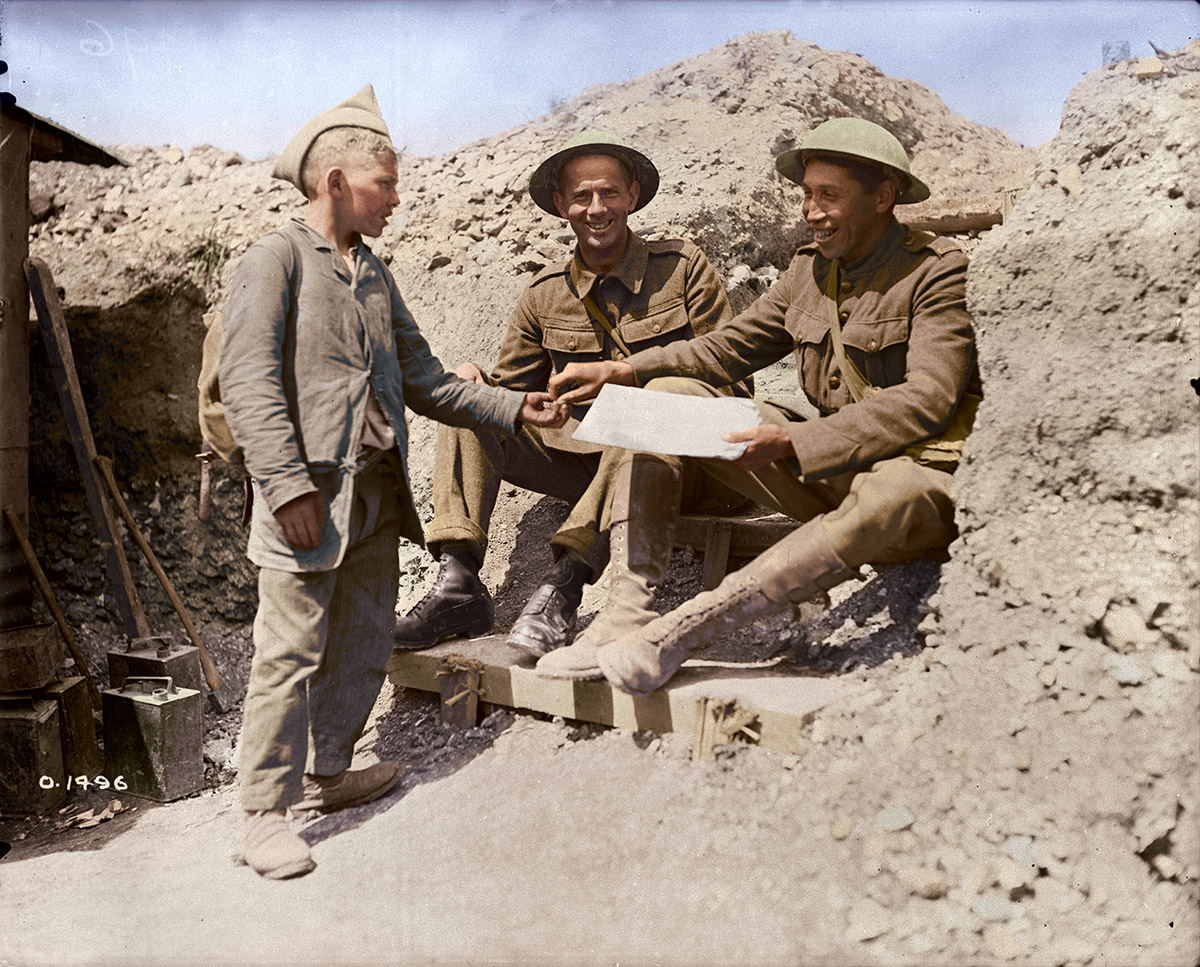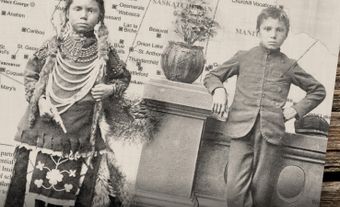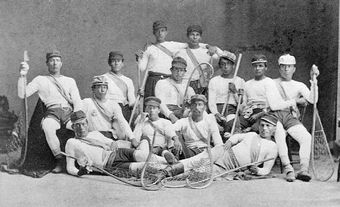Thomas Charles Longboat (Gagwe:gih), distance runner, Olympian (born 4 July 1886 in Ohsweken, Six Nations of the Grand River; died 9 January 1949 in Ohsweken). Tom Longboat was an Onondaga distance runner from Six Nations of the Grand River. One of the most famous athletes of the early 20th century, Longboat pioneered training methods still used today. He is considered one of the first celebrity athletes in Canada, with his athletic successes known across North America and overseas. He was a leader in establishing marathon running as an international sport and won many marathons in record-breaking times, beating competitors from all over the world. Longboat was the first Indigenous person to win the Boston Marathon (1907). He competed for Canada at the 1908 Olympic Games. He was inducted into Canada’s Sports Hall of Fame and the Ontario Sports Hall of Fame.
Early Life
Tom Longboat was born on 4 July 1886 in Ohsweken, Six Nations of the Grand River. He was a member of the Wolf clan and raised in the Longhouse religion (also known as Handsome Lake Religion). Longboat spoke Onondaga and was given the name Gagwe:gih, which translates as “everything.”
Did you know?
There has been some confusion about Tom Longboat’s birthdate. Many sources state that Longboat was born on 4 June 1887. However, the Canadian census of 1901 and Longboat’s military records (particularly his attestation paper, signed by Longboat in Brantford on 17 February 1916) support a birthdate of 4 July 1886.
He was the middle child of George Longboat and Elizabeth Skye. Tom had an older sister, Lucy, and a younger brother, Simon. In 1892, Tom’s father, George, died when Tom was five years old. Tom and his siblings were raised on the family farm, where some stories relate that Tom ran after cows in the fields. In another story from his youth, published in Canada’s History magazine, Tom is said to have run “sixty-five kilometres from Hamilton to Brantford, arriving home before his mother, who had left hours earlier — in a wagon.”

When he was 12 years old, Longboat was forced to attend the Mohawk Institute Residential School in Brantford. While attending the school, he was pressured to conform to Christianity, and to give up his beliefs and language. At the time, cadet-style training and physical activity programs were used as tools for assimilation at the Mohawk Institute under the administration of Rev. Robert Ashton and his son A. Nelles Ashton.
Longboat ran away from the school. He was initially caught and returned there, but he escaped again, and went to live with his uncle.
Did you know?
The Mohawk Institute Residential School was in operation from 1823 to 1970. At the height of his fame, Tom Longboat was asked to speak to the students at the Mohawk Institute. He refused and stated privately, “I wouldn’t even send my dog to that place.”
Haudenosaunee Traditional Runners
Throughout history, distance running for the Haudenosaunee has been about much more than winning races. Whether they were bringing councils together, gathering information from other nations, or identifying oncoming danger, long-distance running has long been a way of life for the Onondaga and Haudenosaunee communities. Runners would often carry messages and stringed wampum to signify their distinct and recognized role as well as diplomatic protocol. They were honoured and respected members of the community and held great value to all they served.

Long Distance Runner
In 1906, when he was 19 years old, Tom Longboat entered the five-mile Victoria Day race in Caledonia, Ontario. After he won, Longboat began to train with Bill Davis, a Kanyen'kehà:ka runner from Six Nations who finished second at the 1901 Boston Marathon. Longboat won the Hamilton Around the Bay road race the following year, beating his closest competitor by over three minutes and nearly tying the race record.
Just two years after he started running competitively, Longboat ran in the 1907 Boston Marathon and won. He set a course record of two hours, 24 minutes and 24 seconds, breaking the previous record by five minutes. Longboat was the first Indigenous person to win the Boston Marathon, and the third Canadian. After winning the race, a celebration for Longboat was held in Toronto, with an estimated 200,000 people in attendance. At the time, North America was in the midst of a “marathon craze.” Not long after the race, Longboat became a household name across the continent and overseas.
Did you know?
Tom Longboat was not the only Indigenous runner to achieve a high level of success in his era. As Kelly Bouchard notes in the Toronto Star: “Ojibway Fred Simpson was sixth in the 1908 Olympic marathon, which Longboat failed to finish, and Paul Acoose of Saulteaux First Nation in Saskatchewan beat Longboat in 1910…. Meanwhile, Albert Smoke, another Ojibway, raced throughout North America in the 1910s before competing at the 1920 Olympics and placing third in Boston.”
Longboat went on to win Toronto’s Ward Marathon for a third time, in 1908, as well as the "World's Professional Marathon Championship" (1909). He also broke numerous records. He was one of the most sought-after performers in the brief revival (1908–12) of professional racing that followed the 1908 London Olympics marathon.

1908 Olympics
Longboat could not compete at the 1908 Boston Marathon because the US Amateur Athletic Union (AAU) considered him a professional runner. The AAU did not believe Longboat was eligible to compete at the 1908 Olympic Games in London, either. The Canadian Amateur Athletic Union (CAAU) initially agreed with the AAU and considered Longboat a professional. However, the CAAU was persuaded by public opinion to disagree with the American assessment of Longboat, and they allowed him to represent Canada in the men’s marathon at the 1908 Olympic Games in London.
Though he was the favourite to win Olympic gold, Longboat did not finish the Olympic race and collapsed at the 20-mile mark. He later blamed the withdrawal on sunstroke. Another competitor, Dorando Pietri, also collapsed in the record-breaking heat. (More than half of the competitors did not finish the race.) The 1908 Olympic marathon was highly controversial, including allegations that a conspiracy against Longboat led to his collapse.
Innovative Training Methods
Tom Longboat is known for following a training method that was decades ahead of its time. His training schedule alternated between intense workouts, lighter training days and recovery periods. According to author Bruce Kidd, Longboat “inherited or acquired [his training methods] through his Indigenous community and those exemplars, and he did so really in a way that many other people subsequently adopted to their advantage.”
Reporters often criticized Longboat for being lazy because he didn’t train as they expected he would: with persistent intensity. Many of these views came from racist assumptions about Indigenous people. In fact, in a 1919 article, sports reporter Lou Marsh called Longboat “the original dummy.” Years later, in a 1922 article Marsh wrote, he said Longboat “was as hard to train as a leopard” (see Lou Marsh Trophy). Despite that constant and often racist criticism, Longboat stuck to his own methods. Longboat's desire to train himself led to several well-publicized conflicts with managers. He bought out his contract in 1911 and ran better than ever. In 1912, he set a professional record of 1:18:10 for 15 miles, 7 minutes faster than his amateur record.
Military Service
In February 1916, Tom Longboat enlisted in the Canadian Armed Forces. He initially joined with the 180th (Sportsmen’s) Battalion, which recruited athlete volunteers. He was transferred to the 107th (Timber Wolf) Battalion, serving as a dispatch carrier along the Western Front in France and Belgium. Longboat’s role as a messenger involved significant danger, and he was incorrectly reported dead at least twice. Initial reports declared that Longboat was killed on 2 October 1917. Longboat was mistakenly declared dead in the Belgium battlefields.
In addition to running messages and orders between units, he also continued to race, winning several inter-battalion sporting contests. In 1918, he won the eight-mile [13 km] race at the Canadian Corps Dominion Day competitions. He survived the war and in 1919 returned to Canada.
Later Life
In the early 1920’s, Longboat moved to Alberta to collect the land granted to him for his military service. However, due to paperwork errors and mix-ups, Longboat was prevented from taking up his land grant. He worked multiple jobs, including one at the Dunlop Rubber Company, as well as being a mailman and steelworker in Buffalo, New York. He would eventually go on to work for the City of Toronto for about 17 years in the street cleaning department. This job gave him the freedom and means to purchase a vehicle during the Great Depression — a luxury that many could not afford.
After retiring from the City of Toronto position, Longboat returned to live in Six Nations. He was eventually diagnosed with diabetes and in 1949 he died of pneumonia in Ohsweken.

Personal Life
Tom Longboat married Lauretta Maracle, a Kanyen'kehà:ka school teacher, and had a reception at Massey Hall in 1908. Lauretta remarried after false reports that Longboat died during the First World War. After he returned home, Longboat married Martha Silversmith, an Onondaga woman, in 1920. The couple had four children.
Did you know?
Longboat’s celebrity status reached such heights that in 1917 he fell victim to identity theft while serving with the Canadian Armed Forces. An American vaudeville singer and con man, Edgar Laplante, travelled around America giving performances as Longboat and profiting from his name. A debate about whether Longboat was truly overseas continued until Longboat threatened legal action against Laplante in 1917.
Honours
In 1951, the Tom Longboat Awards were established in Longboat’s honour. Every year, the Aboriginal Sport Circle presents this award to a female and male Indigenous athlete who demonstrate excellence in sport.
Longboat was inducted as part of the inaugural class of Canada’s Sports Hall of Fame in 1955, and into the Ontario Sports Hall of Fame in 1996. In 2000, Canada Post issued a commemorative stamp for its Millennium Collection. In 2008, Bill 120 proclaimed 4 June of every year Tom Longboat Day in Ontario. Each year, a run is organized by members of the Longboat family and hosted in Six Nations to commemorate Tom Longboat Day.
Significance and Legacy
Tom Longboat was one of the most famous athletes of the early 20th century. His name was known throughout North America and overseas. He helped establish marathon running as an international sport and won marathons in record-breaking times, beating competitors from all over the world. Longboat was a significant figure in the sports world who was unconcerned with how others viewed him.
Longboat’s pride and connection to his Onondaga heritage and traditions drove him throughout his competitive life. He was proud of his nation’s traditional way of life, the Longhouse religion, and their spoken language. Longboat's story is representative of the incredible abilities and skills utilized by Indigenous communities long before European contact. He faced baseless, racist stereotypes about his people and their ability to compete, as well as structurally racist practices at residential schools.
Meet Tom Longboat, an Onondaga long distance runner born in Six Nations. Tom became one of the most celebrated athletes of all time, despite his struggles and encountering racism throughout his career.
Note: The Secret Life of Canada is hosted and written by Falen Johnson and Leah Simone Bowen and is a CBC original podcast independent of The Canadian Encyclopedia.

 Share on Facebook
Share on Facebook Share on X
Share on X Share by Email
Share by Email Share on Google Classroom
Share on Google Classroom










